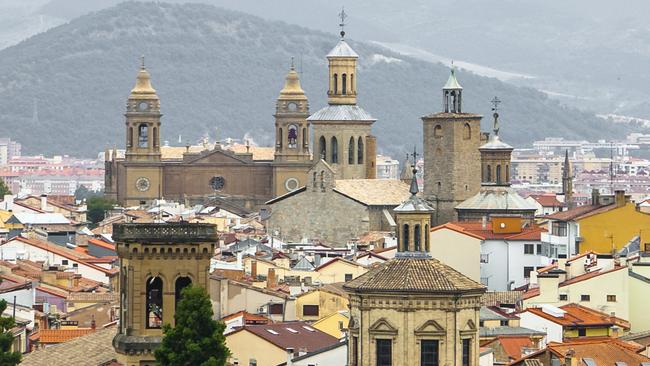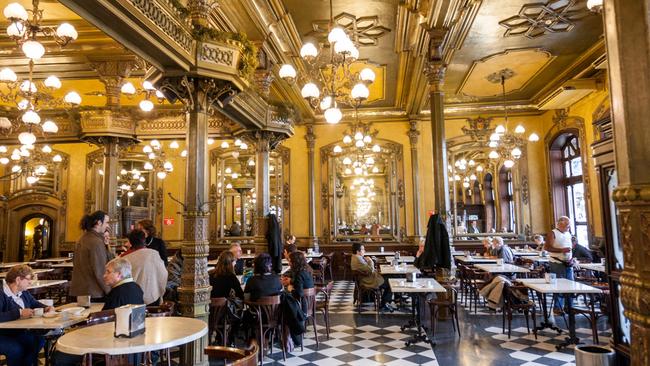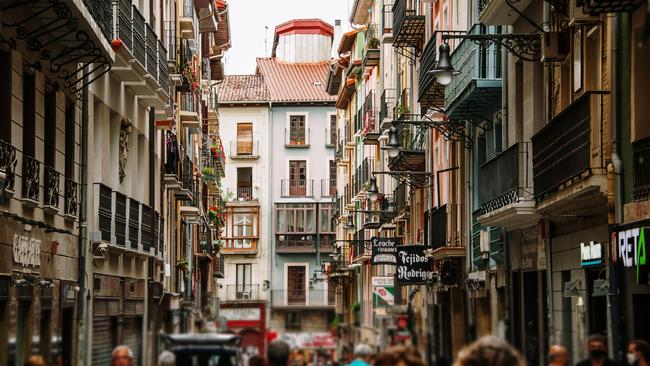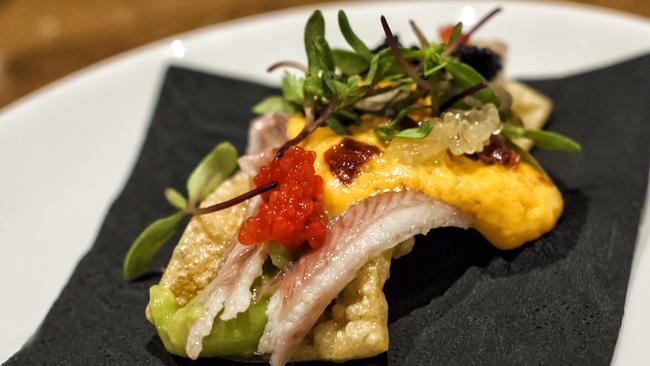Things to do in Pamplona
Pamplona, the lesser-known culinary capital of Spain’s Basque region, deserves to be known for more than the running of the bulls.

San Sebastian often steals the spotlight for its culinary delights, but neighbouring Pamplona deserves to be known for more than the running of the bulls. Here are 10 ways to explore the lesser-known culinary capital of the Basque region.
1. Viennese-style Café Iruña (below) on the Plaza del Castillo main square opened in 1888 and remains a favourite haunt for coffee, cakes and opulence. Tourists flock here for the Hemingway connection. The US author set scenes in these chandeliered and mirrored surrounds in The Sun Also Rises, the book that popularised Pamplona’s running of the bulls. There’s a rear bar, El Rincon Hemingway, with a statue and B&W photos of the author; it’s a hot destination for selfie shots. Upstairs from Iruña is private members club Nuevo Casino, which after 150 years has opened its doors to the public. It’s a lavish affair of parquetry, marble-topped tables and gilded chandeliers, serving well-priced lunchtime menus of the day and bar snacks at night. Closed Mondays, “due to weekly rest”.

2. To understand the Pamplonican obsession with small skewer foods, visit Iruñazarra. Under innovative chef Gorka Aguinaga, the restaurant’s been a serial winner or placegetter in Navarre’s annual pintxos (tapas) festival. The menu is a greatest-hits collation of miniature creations such as setera, a still-life scene of mushrooms growing in a forest, all of it edible. Another creation, El Itsasantxoa, blitzed the competition in 2020. It features a cute tortilla-and-squid-ink boat crewed with various anchovy preparations, from crisp-fried to mousse, served in a silver chest with a treasure map of Basque region pintxos. Iruñazarra also serves the province of Navarra’s award-winning croquette for 2022, the prawn and leek-filled melosa. Best eaten with a spoon.
3. To really understand Navarran food culture, book an insider tour, such as those run by Beatriz (Bea) Etayo, of Pamplona Food. How else would you learn that the litmus test of any Navarran eatery is the croqueta (croquette)? The advice is to always order one first to see if the place is any good. During an indulgent Sunday city crawl, we snack on chorizo-like txistorra sausage and gildas, toothpick skewers of piquillo peppers, olives and silver-white fillets of Cantabrian anchovies. We visit, among other places, the Larramendi ice creamery, started by two local sisters, the fourth-generation lolly shop Garrarte and the Navarra-centric deli Gurgur, its shelves packed tight with local cheeses, tinned white asparagus and Madrágora, a mandrake potion that gives Navarran witches the power of flight. Or so I’m told.
4. Pamplona is known globally for the running of the bulls, a tradition dating back several centuries and linked, as with everything here, to food. The first bullfight took place in the city’s main square in 1385; the running of the bulls began after local butchers, keen to secure the tastiest-looking beasts for their customers, started running alongside the animals as they stampeded from outside the city walls into the bullring. Known as sanfermines, the bull-running festival happens annually between July 6-14. Outside that fevered week visitors can tap into the spirit on a tour of the circa 1922 bullring and by keeping tabs on how many Hemingway statues there are in the old city (I count three).
5. Navarran wines are often eclipsed by those of neighbouring La Rioja, Spain’s wine capital, but provincial growers make very fine, fruity reds (tempranillo, cab sav and merlot, mainly) as well as elegant chardonnays and rosés. Sample these at Chez Belagua, a popular cider house on Estafeta Street where owners Juan Carlos and Rosa Oroz also have a thing for wine. Their little streetside bar, El Rincon del Chez, serves more than 80 labels from Spain and beyond, all by the glass with classic Basque snacks on the side. All the wines, plus natural ciders, are available at Belagu.

6. Hostería del Temple’s barmen are the friendliest in town but it’s upstairs where the real hospitality happens. At this rustic restaurant, tucked beneath the beams of an ancient inn, diners sit on cushioned wood chairs at tables dressed in Basque linens in a space surrounded by art, ceramics and homely clutter. Famous for the moscovita, a plump fritter stuffed with ham, gooey Emmental and boiled egg, El Temple also offers an economical three-course menu del día for €15 on weekdays. Homemade, seasonal and typical, its Navarran dishes include salt cod, stews and tiny, delicious lamb chops. 3 calle Curia.
7. They’re not World Heritage-listed (yet) but Pamplona’s medieval city walls are largely intact and offer broad outlooks over the surrounding landscape. Gaze east to the Pyrenees, which are almost visible on a clear day, and inhale cooling northern breezes blowing in from the Cantabrian Sea. There’s a signposted walk, Paseo de Ronda, tracing the one-time soldiers’ circuit along the battlements, which were so effective they stopped the march of the Moors further north into Christian Spain and France. Look out for the Romanesque bridge of La Magdalena, the drawbridge outside the France Gate, and take a break at the Meson de Caballo Blanco’s rose-garden and magnolia-shaded terrace, best enjoyed over sunsets and spritzes.

8. At Café Compañia the charming owners serve properly good espresso and cold-drip coffee, a diverse range of teas and vegan options such as charcoal or butterfly-pea chai. To eat, there’s chocolate, toasties, smoothies, bagels and cakes, served in a split-level space where the basement is a 2000-year-old Roman bath. You can take coffee down here, surrounded by ancient stone, or on the cobbled street watching pilgrims pass by on the Santiago de Camino trail. 1 calle Compañia.
9. San Sebastian is known for its txokos, the famously exclusive gastronomic societies where men gather to cook haute cuisine. Pamplona’s much more democratic equivalent are the peñas, run as co-ops or “friendly societies” open to all ages and genders. Dotted throughout the old city, they’re easily identified by flags hung over their doorways, especially in Jarauta Street. During sanfermines, the peñas play a pivotal role selling tickets, escorting spectators to the bullring by brass band (each peña has its own) and operating streetside bars, which are open to all. Outside bull-running season, locals are only too happy to show you their peñas, if you ask nicely.
10. Hotel Alma’s zinc-panelled facade and modernist bones seem a little incongruous in its leafy riverside setting on the city fringe. But step inside and you’ll understand the lovely synergy at play here. Alma is close to central Pamplona, just a short bike or taxi ride, or longer stroll along the river, but suitably removed so that guests are cocooned from any bull-running madness. Its 54 guestrooms are arranged over three floors, many with balconies or terraces (executive suites are the ones to book) and contemporary art everywhere, designer furnishings, coffee machines, and a subterranean spa with Roman-style saltwater bath. For all its charms, gastronomy is Alma’s strong suit. Of the two restaurants, Alma serves traditional Navarran cuisine while La Biblioteca is a Michelin-starred space of just four tables for a maximum 10 people. The 22-course menu explores endemic roots and vegetables, which is not as spartan as it sounds. Dishes include kohlrabi ravioli filled with broccoli and a broccoli root cream, and a broth of artichoke-like cardoon roots.

To join the conversation, please log in. Don't have an account? Register
Join the conversation, you are commenting as Logout